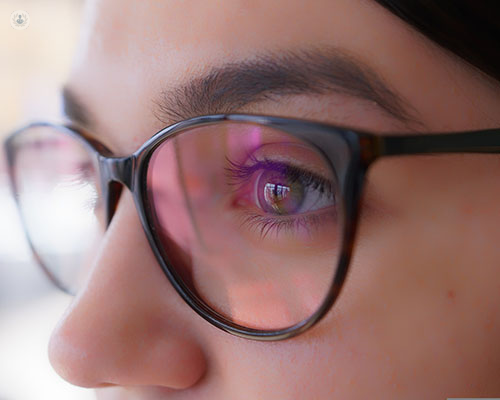What is corneal cross-linking?
Corneal cross-linking, often abbreviated as CXL, is a medical procedure used to treat certain eye conditions, such as keratoconus and corneal ectasia. It involves the application of riboflavin (vitamin B2) eye drops and ultraviolet (UV) light to strengthen the cornea, the transparent front part of the eye.

How does corneal cross-linking work?
During corneal cross-linking, riboflavin eye drops are applied to the cornea. These eye drops are then activated by UV light. The interaction between riboflavin and UV light causes the formation of chemical bonds within the corneal collagen fibres, increasing their strength and stability.
What conditions can be treated with corneal cross-linking?
Corneal cross-linking is primarily used to treat progressive conditions like keratoconus and corneal ectasia, where the cornea becomes weak and starts to bulge, leading to vision problems.
Is corneal cross-linking a surgical procedure?
Corneal cross-linking is a minimally invasive procedure that does not involve surgical incisions. It is performed in an outpatient setting using eye drops and UV light.
What are the potential risks and side effects of corneal cross-linking?
Common side effects may include temporary discomfort, light sensitivity, and blurred vision. Serious complications are rare but can include infection or corneal scarring.
How long does the recovery process take after corneal cross-linking?
The initial recovery period usually lasts a few days to a week. Patients may experience discomfort and blurred vision during this time. Full visual recovery can take several weeks to months.
Is corneal cross-linking effective in stopping the progression of keratoconus?
Yes, corneal cross-linking is an effective treatment for halting the progression of keratoconus and stabilising the cornea. It can prevent the need for more invasive procedures like corneal transplants in many cases.
What is the long-term outlook for someone who has undergone corneal cross-linking?
Corneal cross-linking is generally considered a long-lasting treatment that can stabilise the cornea and improve visual outcomes. Regular follow-up with an ophthalmologist is essential to monitor the eye's condition over time.
09-08-2016 09-11-2023
Corneal cross-linking
Mr Mrinal Rana - Ophthalmology
Created on: 09-08-2016
Updated on: 09-11-2023
Edited by: Conor Dunworth
What is corneal cross-linking?
Corneal cross-linking, often abbreviated as CXL, is a medical procedure used to treat certain eye conditions, such as keratoconus and corneal ectasia. It involves the application of riboflavin (vitamin B2) eye drops and ultraviolet (UV) light to strengthen the cornea, the transparent front part of the eye.

How does corneal cross-linking work?
During corneal cross-linking, riboflavin eye drops are applied to the cornea. These eye drops are then activated by UV light. The interaction between riboflavin and UV light causes the formation of chemical bonds within the corneal collagen fibres, increasing their strength and stability.
What conditions can be treated with corneal cross-linking?
Corneal cross-linking is primarily used to treat progressive conditions like keratoconus and corneal ectasia, where the cornea becomes weak and starts to bulge, leading to vision problems.
Is corneal cross-linking a surgical procedure?
Corneal cross-linking is a minimally invasive procedure that does not involve surgical incisions. It is performed in an outpatient setting using eye drops and UV light.
What are the potential risks and side effects of corneal cross-linking?
Common side effects may include temporary discomfort, light sensitivity, and blurred vision. Serious complications are rare but can include infection or corneal scarring.
How long does the recovery process take after corneal cross-linking?
The initial recovery period usually lasts a few days to a week. Patients may experience discomfort and blurred vision during this time. Full visual recovery can take several weeks to months.
Is corneal cross-linking effective in stopping the progression of keratoconus?
Yes, corneal cross-linking is an effective treatment for halting the progression of keratoconus and stabilising the cornea. It can prevent the need for more invasive procedures like corneal transplants in many cases.
What is the long-term outlook for someone who has undergone corneal cross-linking?
Corneal cross-linking is generally considered a long-lasting treatment that can stabilise the cornea and improve visual outcomes. Regular follow-up with an ophthalmologist is essential to monitor the eye's condition over time.


I have keratoconus, will I lose my sight?
By Mr Arun Brahma
2024-10-31
Keratoconus primarily affects the cornea and is a condition that means the cornea has become cone-shaped. Naturally, as with any eye condition, patients worry that they'll lose their sight. Mr Arun Brahma explains what you should know about keratoconus and preserving your sight. See more


How much do you know about Keratoconus?
By Mr Vincenzo Maurino
2024-10-23
We're raising awareness for World Keratoconus Day! Expert Vincenzo Maurino explains the keratoconus signs to watch out for, and how KC can be treated. See more
Experts in Corneal cross-linking
-
Miss Valerie Saw
OphthalmologyExpert in:
- Cataracts
- Laser eye surgery
- Dry eye
- Keratoconus
- Corneal transplant
- Corneal cross-linking
-
Professor Parwez Hossain
OphthalmologyExpert in:
- Cataracts
- Pterygium and pinguecula
- Blepharitis
- Corneal cross-linking
- Corneal transplant
- Keratitis
-
Mr Aris Konstantopoulos
OphthalmologyExpert in:
- Cataracts
- Laser eye surgery
- Keratoconus
- Corneal transplant
- Corneal cross-linking
- Lens replacement (intraocular lenses)
-
Mr Geraint Williams
OphthalmologyExpert in:
- Cataracts
- Lens replacement (intraocular lenses)
- Corneal transplant
- Corneal cross-linking
- YAG laser capsulotomy
- Dry eye
-
Mr Ahmed Abdelmaksoud
OphthalmologyExpert in:
- Dry eye
- Refractive surgery
- Laser eye surgery
- Multifocal contact lenses
- Keratoconus
- Corneal cross-linking
- See all

Tunbridge Wells Eye Centre
Tunbridge Wells Eye Centre
7 Vale Ave, Tunbridge Wells TN1 1DJ
No existe teléfono en el centro.
By using the telephone number provided by TOP DOCTORS, you automatically agree to let us use your phone number for statistical and commercial purposes. For further information, read our Privacy Policy
Top Doctors

Laser Vision Eye Centre
Laser Vision Eye Centre
Winchester Road, Chandler's Ford, Eastleigh
No existe teléfono en el centro.
By using the telephone number provided by TOP DOCTORS, you automatically agree to let us use your phone number for statistical and commercial purposes. For further information, read our Privacy Policy
Top Doctors
-
Tunbridge Wells Eye Centre
7 Vale Ave, Tunbridge Wells TN1 1DJ, Tunbridge WellsExpert in:
- Cataracts
- Oculoplastics surgery
- Laser eye surgery
- Refractive surgery
- Facial aesthetics
- Ophthalmology
-
Laser Vision Eye Centre
Winchester Road, Chandler's Ford, Eastleigh , EastleighExpert in:
- Advanced surface ablation
- Laser eye surgery
- ICL lens implants
- Presbyopia (Presbyond)
- Keratoconus
- SMILE
- See all
- Most viewed diseases, medical tests, and treatments
- Minimal access surgery (keyhole surgery)
- Botulinum toxin (Botox™)
- Medicolegal
- Dermal fillers
- Headache
- Strabismus (squint)
- Glaucoma
- Diplopia (double vision)
- Amblyopia
- Vision therapy







